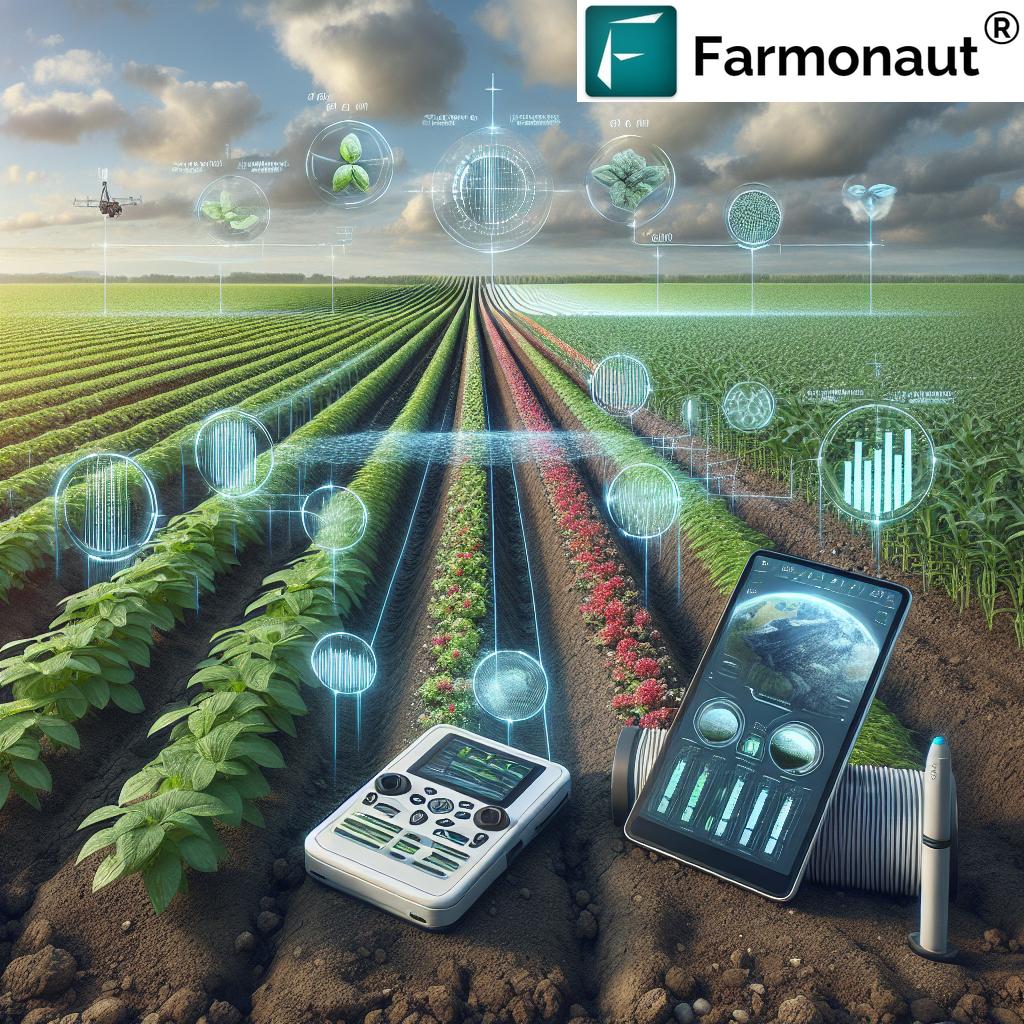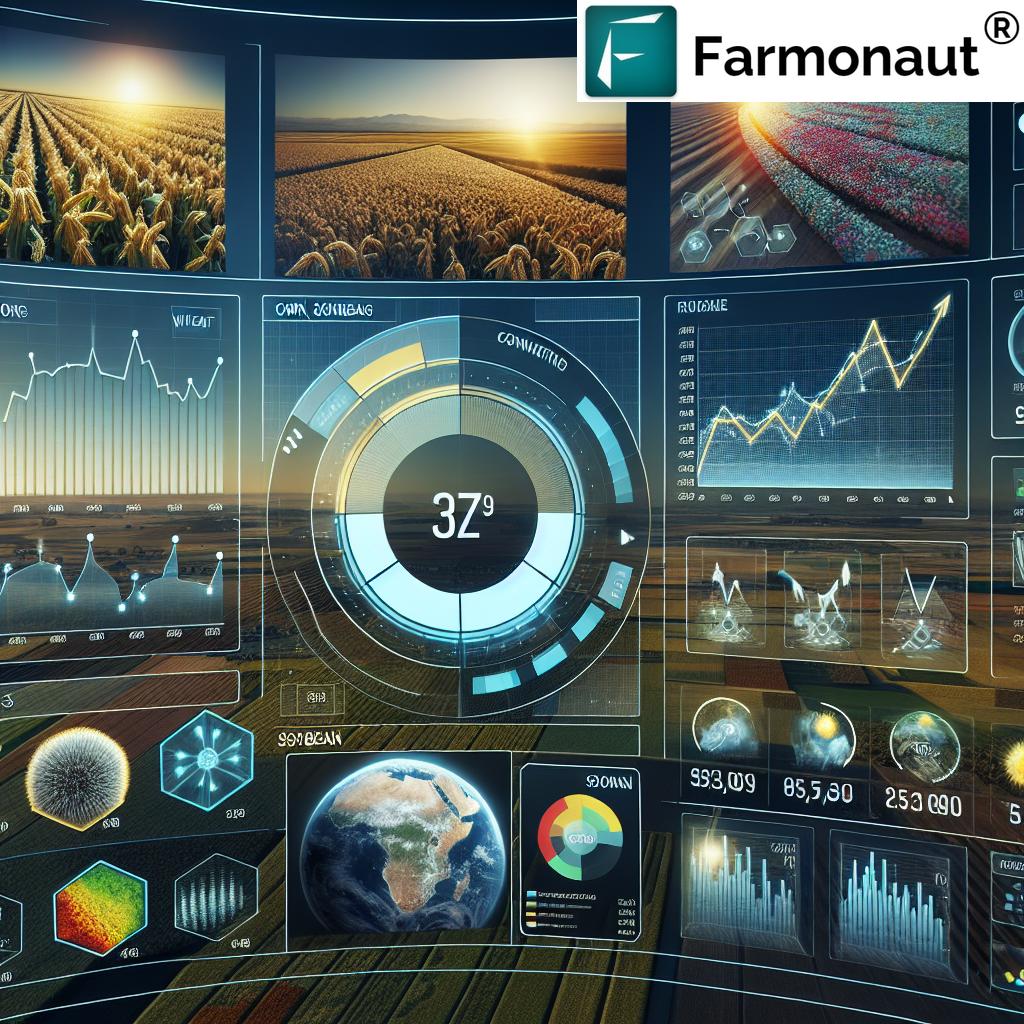Revolutionizing Australian Wine Exports: How GIS and AgTech Are Transforming Sustainable Winegrowing
“Australian wine exports utilize GIS technology in over 65% of vineyards, enhancing precision viticulture and sustainable practices.”
Welcome to the exciting world of Australian wine exports, where tradition meets innovation in the quest for sustainable winegrowing. In this comprehensive guide, we’ll explore how cutting-edge Geographic Information Systems (GIS) and agricultural technology (AgTech) are reshaping the landscape of the Australian wine market. From the sun-drenched vineyards of South Australia to the cool-climate regions of Tasmania, we’re witnessing a revolution in vineyard management and wine export Australia practices.
As we delve into this transformative journey, we’ll uncover how Farmonaut’s innovative AgTech solutions are playing a pivotal role in elevating the Australian wine industry to new heights. Our exploration will cover everything from sustainable winegrowing techniques to the intricacies of wine labelling requirements and export regulations. We’ll also examine how these advancements are helping Australian winemakers adapt to climate change, enhance product quality, and meet the evolving demands of global markets.

The Role of GIS in Modern Viticulture
GIS in viticulture has become an indispensable tool for Australian winemakers. This technology allows for precise mapping and analysis of vineyard conditions, enabling growers to make data-driven decisions that optimize grape quality and yield. Let’s explore how GIS is revolutionizing various aspects of vineyard management:
- Soil Analysis: GIS helps in creating detailed soil maps, allowing vintners to understand the composition and characteristics of their terroir.
- Irrigation Management: By integrating soil moisture sensors with GIS, winegrowers can implement precision irrigation strategies, conserving water and improving grape quality.
- Pest and Disease Monitoring: GIS enables early detection and targeted treatment of vineyard pests and diseases, reducing the need for broad-spectrum pesticides.
- Harvest Planning: Using GIS data, winemakers can optimize harvest timing based on grape maturity across different vineyard blocks.
Farmonaut’s satellite-based crop health monitoring system takes these capabilities to the next level. By providing real-time data on vegetation health (NDVI) and soil moisture levels, Farmonaut empowers Australian winegrowers to make informed decisions that enhance both efficiency and sustainability.
Sustainable Winegrowing Practices in Australia
Sustainable winegrowing is not just a trend; it’s a necessity for the future of the Australian wine industry. As climate change continues to impact viticulture, winegrowers are adopting innovative practices to ensure the longevity and quality of their vineyards. Here are some key sustainable practices being implemented:
- Water Conservation: Drip irrigation systems and moisture sensors help reduce water usage while maintaining optimal vine health.
- Cover Cropping: Planting cover crops between vine rows improves soil health, reduces erosion, and enhances biodiversity.
- Integrated Pest Management: Using natural predators and targeted interventions to control pests, reducing reliance on chemical pesticides.
- Renewable Energy: Many wineries are investing in solar panels and wind turbines to power their operations sustainably.
Farmonaut’s Jeevn AI Advisory System plays a crucial role in supporting these sustainable practices. By providing personalized farm advisory and real-time insights, it helps winegrowers optimize their resource use and implement environmentally friendly strategies.
Navigating Wine Export Regulations and Labelling Requirements
For Australian winemakers looking to tap into international markets, understanding wine export regulations and wine labelling requirements is crucial. These regulations ensure product quality, authenticity, and consumer safety. Here’s what exporters need to know:
- Geographical Indications (GIs): Protect the reputation of wine regions and ensure truthful labelling of wine origins.
- Alcohol Content: Must be accurately stated on the label within allowable tolerances.
- Additives and Allergens: Any additives or potential allergens must be clearly declared on the label.
- Organic Certification: For organic wine production, specific certification processes must be followed and indicated on the label.
Farmonaut’s blockchain-based traceability solution can be a game-changer in this area. By providing a transparent and secure record of the wine’s journey from grape to bottle, it helps ensure compliance with labelling requirements and builds consumer trust.

Climate Change and Its Impact on Australian Viticulture
“Climate change has led to a 15% shift in optimal grape-growing regions across Australia in the last decade.”
The climate impact on viticulture is one of the most pressing challenges facing the Australian wine industry. Rising temperatures, changing rainfall patterns, and increased frequency of extreme weather events are altering the landscape of wine production. Here’s how climate change is affecting Australian vineyards and how the industry is adapting:
- Shifting Growing Regions: Cooler climate varieties are being planted at higher altitudes or in more southern regions.
- Earlier Harvests: Warmer temperatures are leading to earlier ripening, requiring adjustments in harvest timing and winemaking processes.
- Water Scarcity: Drought conditions are prompting the adoption of water-efficient irrigation systems and drought-resistant grape varieties.
- Increased Disease Pressure: Warmer, more humid conditions can lead to higher incidence of fungal diseases, necessitating improved vineyard pest management strategies.
Farmonaut’s satellite-based monitoring system and AI-driven insights are invaluable tools in addressing these challenges. By providing real-time data on climate conditions and crop health, Farmonaut enables winegrowers to make timely decisions and implement adaptive strategies.
Innovations in Wine Production and Processing
Wine industry innovation extends beyond the vineyard into the winery itself. Australian winemakers are embracing cutting-edge technologies to enhance wine quality, improve efficiency, and reduce environmental impact. Some notable innovations include:
- Optical Grape Sorting: High-speed cameras and AI algorithms sort grapes based on quality, ensuring only the best fruit makes it into the wine.
- Precision Fermentation: Temperature-controlled fermentation tanks with automated monitoring systems allow for precise control over the winemaking process.
- Sustainable Packaging: Lightweight glass bottles, alternative packaging materials, and recycling programs are reducing the industry’s carbon footprint.
- Smart Cellar Management: IoT sensors and cloud-based systems help track inventory, monitor wine aging, and optimize storage conditions.
Farmonaut’s fleet and resource management tools can be adapted to support these innovations, helping wineries optimize their operations and reduce waste throughout the production process.
Explore Farmonaut’s API for custom integrations
Exploring Australia’s Diverse Wine Regions and Varieties
The diversity of Australian wine regions and varieties is a key strength of the country’s wine industry. From the bold Shiraz of the Barossa Valley to the crisp Rieslings of the Clare Valley, Australia offers a wide range of styles to suit every palate. Let’s take a tour of some of the country’s most renowned wine regions:
- Barossa Valley, South Australia: Known for its full-bodied Shiraz and old-vine Grenache.
- Margaret River, Western Australia: Produces world-class Cabernet Sauvignon and Chardonnay.
- Yarra Valley, Victoria: Cooler climate region famous for Pinot Noir and sparkling wines.
- Hunter Valley, New South Wales: Australia’s oldest wine region, renowned for its Semillon and Shiraz.
- Tasmania: Emerging cool-climate region producing exceptional Pinot Noir and sparkling wines.
Farmonaut’s satellite monitoring and AI advisory systems can be tailored to the specific needs of each region, helping growers optimize their practices for the unique terroir and climate conditions of their vineyards.
Access Farmonaut’s API Developer Docs for advanced integration
Wine Tourism and Its Impact on Exports
Wine tourism Australia plays a significant role in promoting Australian wines both domestically and internationally. By offering unique experiences and direct connections with winemakers, wine tourism helps build brand loyalty and drives export demand. Here’s how wine tourism is evolving and contributing to the export market:
- Cellar Door Experiences: Wineries are offering immersive tasting experiences, often paired with local cuisine.
- Wine Trails: Regions are developing themed wine routes that showcase the diversity of local producers.
- Virtual Tastings: In response to travel restrictions, many wineries now offer virtual tasting experiences, reaching international audiences.
- Eco-Tourism: Sustainable and organic wineries are attracting environmentally conscious visitors, aligning with global trends.
Farmonaut’s digital solutions can enhance wine tourism experiences by providing interactive maps and real-time vineyard data, offering visitors a deeper understanding of the winemaking process.
Wine Marketing Strategies for Global Markets
Effective wine marketing strategies are essential for success in competitive global markets. Australian wine exporters are leveraging a combination of traditional and digital marketing techniques to reach consumers worldwide. Key strategies include:
- Brand Storytelling: Highlighting the unique stories and heritage of Australian wineries to create emotional connections with consumers.
- Digital Marketing: Utilizing social media, influencer partnerships, and targeted online advertising to reach specific market segments.
- Sustainability Messaging: Emphasizing eco-friendly practices and organic certifications to appeal to environmentally conscious consumers.
- Food Pairing Promotions: Collaborating with chefs and restaurants to showcase the versatility of Australian wines with various cuisines.
Farmonaut’s data-driven insights can support these marketing efforts by providing verifiable information on sustainable practices and vineyard management, enhancing the authenticity of brand messaging.
Challenges and Opportunities in Key Export Markets
Australian wine exporters face both challenges and opportunities in key international markets. Understanding the nuances of each market is crucial for success. Let’s examine some important export destinations:
- China: Despite recent trade tensions, China remains a significant market with long-term potential. Exporters are focusing on building brand loyalty and exploring e-commerce channels.
- United States: The world’s largest wine market offers opportunities for premium Australian wines. Emphasis on regional diversity and sustainability can help differentiate Australian offerings.
- United Kingdom: A traditional stronghold for Australian wines, the UK market is evolving post-Brexit. Exporters are adapting to new trade agreements and changing consumer preferences.
- Canada: With a growing appreciation for New World wines, Canada presents opportunities for both established brands and boutique producers.
- Japan and South Korea: These markets show increasing interest in Australian wines, particularly in the premium segment. Cultural understanding and tailored marketing approaches are key.
Farmonaut’s blockchain-based traceability solution can be particularly valuable in these markets, providing transparency and authenticity that discerning consumers demand.
The Future of Australian Wine Exports: Trends and Predictions
As we look to the future of wine export Australia, several trends and developments are likely to shape the industry:
- Alternative Packaging: Increased adoption of sustainable packaging solutions, including lightweight bottles, cans, and bag-in-box formats.
- Focus on Sustainability: Growing emphasis on organic and biodynamic practices, with a push towards carbon-neutral wine production.
- Emerging Varieties: Experimentation with climate-adapted grape varieties to meet changing environmental conditions and consumer tastes.
- Personalization: Use of data analytics to offer personalized wine recommendations and tailored marketing messages to consumers.
- Blockchain Integration: Wider adoption of blockchain technology for supply chain transparency and authenticity verification.
Farmonaut’s suite of AgTech solutions is well-positioned to support these future trends, offering the data-driven insights and technological infrastructure needed to adapt and thrive in a changing industry landscape.
Conclusion: Embracing Technology for a Sustainable Future
The Australian wine industry stands at the forefront of innovation, leveraging cutting-edge technologies like GIS and AgTech to transform sustainable winegrowing practices and enhance export potential. From precision viticulture to blockchain-based traceability, these advancements are helping Australian winemakers produce higher quality wines while reducing environmental impact.
As we’ve explored in this comprehensive guide, the integration of Farmonaut’s innovative solutions plays a crucial role in this transformation. By providing real-time data, AI-driven insights, and robust management tools, Farmonaut empowers Australian winegrowers to make informed decisions, optimize their operations, and meet the evolving demands of global markets.
The future of Australian wine exports is bright, with technology paving the way for increased sustainability, quality, and market competitiveness. As the industry continues to adapt to challenges like climate change and shifting consumer preferences, the innovative spirit and technological adoption demonstrated by Australian winemakers will undoubtedly keep them at the forefront of the global wine scene.
Farmonaut Satellite System Impact on Australian Wine Exports
| Vineyard Management Aspect | Traditional Methods | With Farmonaut Satellite System | Export Impact |
|---|---|---|---|
| Irrigation Efficiency | Manual scheduling based on visual inspection | Precision irrigation guided by real-time soil moisture data (30% water savings) | Improved grape quality leads to better wine ratings and increased export demand |
| Pest Detection | Regular manual field scouting | Early detection through satellite imagery analysis (50% reduction in pesticide use) | Meets stringent pesticide regulations in export markets, enhancing marketability |
| Harvest Timing | Based on general ripeness indicators | Optimized using NDVI data for precise maturity assessment (15% yield improvement) | Consistent wine quality across vintages, building brand reliability in export markets |
| Soil Health Monitoring | Annual soil testing | Continuous monitoring through satellite data (20% increase in nutrient efficiency) | Enhanced terroir expression, differentiating Australian wines in competitive markets |
| Climate Adaptation | Reactive measures to weather events | Proactive planning using AI-driven climate forecasts (40% reduction in climate-related losses) | Improved resilience to climate variability, ensuring stable supply for export commitments |
FAQ Section
Q: How is GIS technology improving Australian wine production?
A: GIS technology enhances precision viticulture by providing detailed mapping and analysis of vineyard conditions. This allows for optimized irrigation, targeted pest management, and improved harvest planning, ultimately leading to higher quality grapes and more consistent wine production.
Q: What are the main challenges facing Australian wine exports?
A: Key challenges include climate change impacts, evolving market preferences, international trade tensions, and competition from other wine-producing countries. Australian exporters are addressing these through innovation, sustainability initiatives, and strategic marketing efforts.
Q: How is the Australian wine industry adapting to climate change?
A: The industry is adapting by planting new varieties suited to warmer climates, shifting growing regions to cooler areas, implementing water-efficient irrigation systems, and using technology like Farmonaut’s satellite monitoring to make data-driven decisions in vineyard management.
Q: What role does sustainability play in Australian wine exports?
A: Sustainability is increasingly important for Australian wine exports. Many wineries are adopting organic and biodynamic practices, reducing carbon emissions, and implementing water conservation techniques. These efforts appeal to environmentally conscious consumers in key export markets.
Q: How can small Australian wineries compete in the global market?
A: Small wineries can compete by focusing on unique, high-quality products, leveraging Australia’s diverse terroir, and utilizing digital marketing strategies. Technologies like Farmonaut’s platform can help small producers optimize their operations and ensure consistent quality, enhancing their competitiveness.
















